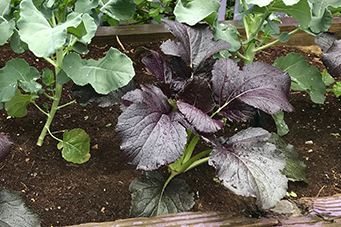| |
UT Gardens’ October 2018 Plant of the Month: Mizuna
By Holly Jones
A mixed baby greens farmer first introduced me to mizuna 10 years ago and I’ve been growing it ever since. I worked on his farm in Haiku, Hawaii, for two years where we grew six varieties of greens for salad mix. Mizuna, or Brassica rapa var. niposinica, was the most reliable, fastest growing one of them all. Though it is technically a mustard, mizuna is so mild that we used it as the basis for the hundreds of pounds of salad mix that we delivered once a week to one of the island’s top resorts. Luckily for us mainlanders, mizuna doesn’t require a tropical island to thrive. This seed-grown biennial performs well in temperate climates, providing attractive, nutritious leaves for much of the growing season.
| |

|
| |
Among the purple selections of mizuna is 'Red Kingdom' (shown in the foreground). This mizuna was named an All-America Selections Edible Winner in 2016; photo by H. Jones, courtesy UTIA.
|
Mizuna exhibits both heat and cold tolerance, which means you can stretch your harvest window into late spring/early summer and through the fall into early winter during most years. It tends to bolt once summer temperatures consistently hit 90 degrees and hotter, but you can start growing it again in early fall when the weather begins to cool. It grows best with full sun exposure in rich, moist, well-drained soil but it is also tolerant of light shade, lean soil and low moisture. Flea beetles are the only pest that has bothered mizuna in our UT Kitchen Garden in Knoxville. One solution is to use row covers, or you can pull the plants out and start over in a different spot later in the season.
In the U.S., mizuna has become a common ingredient in fresh salad mix, but in Japan and throughout Asia, it’s most often cooked in soups, stir-fry or pot stickers. It can be harvested as microgreens, as tender baby greens or as a cut-and-come-again leafy green. Farmers generally direct sow the seeds, but the plant can be easily be transplanted as well. Cornell University lists 16 different varieties on its Vegetable Varieties for Gardeners website, but chances are good that there are even more than that.
The most common type is green and frilly with a tender white stem that can be eaten along with the leaf. It looks great as a border plant in the vegetable garden or mixed into a cool-season container. There are also beautiful red and purple selections. ‘Red Kingdom’ was named an All-America Selections Edible Winner in 2016, and it’s my new favorite variety. It looks very similar to the strong flavored ‘Red Giant’ mustard, but it tastes light and sweet with a mild pepper undertone.
You can find both red and green varieties of mizuna growing in the UT Gardens, Knoxville, this fall.
The UT Gardens includes plant collections located in Knoxville, Jackson and Crossville. Designated as the official botanical garden for the State of Tennessee, the collections are part of the UT Institute of Agriculture. The Gardens’ mission is to foster appreciation, education and stewardship of plants through garden displays, educational programs and research trials. The Gardens are open during all seasons and free to the public. For more information, see the Gardens website: ag.tennessee.edu/utg.
Published October 3, 2018 |

